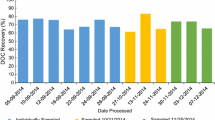Abstract
The report presents results of experiments testifying to the possibility of using wet oxidation to determine the concentrations of organic carbon in marine particulate matter. We describe a method for eliminating the measurement error caused by the influence of chlorides on the processes of dichromate oxidation of organic matter. We present an equation to calculate the concentration of organic carbon depending on that of sodium chloride.
Similar content being viewed by others
References
Manual on Modern Biochemical Analysis of Aquatic Ecosystems Prospective of Fishery and Aquaculture, Ed. by A. I. Agatova (VNIRO, Moscow, 2004) [in Russian].
G. G. Vinberg, V. S. Ivlev, T. P. Platova, and L. L. Rossolimo, “Analysis of organic matter: caloric assessment of food reserves in a reservoir,” in Transactions of Limnological Experimental Station in Kosino (Gidrometeoizdat, Moscow, 1934), Vol. 18, pp. 25–40.
G. A. Vinogradov, “Osmotic regulation of some glacial relict crustacean related to their specific ecology and origin,” in Salinity Resistance of Aquatic Organisms (Zoological Institute, Academy of Sciences of Soviet Union, Leningrad, 1976), pp. 176–209.
Yu. G. Giginyak, “Caloric content of aquatic invertebrates,” in General Principles of Analysis of Aquatic Ecosystems (Nauka, Leningrad, 1979), pp. 43–57.
N. N. Zubov, Oceanological Tables (Gidrometeoizdat, Leningrad, 1957) [in Russian].
M. P. Maksimova, “Comparative hydrochemistry of the seas,” in New Concepts in Oceanology (Nauka, Moscow, 2004), Vol. 1, pp. 168–189.
A. P. Ostapenya, “Assessment methods of the caloric content of the body substances of aquatic organisms,” in Assessment Methods of Production of Aquatic Animals (Academy of Sciences of Belorussia, Minsk, 1968), pp. 26–38.
A. P. Ostapenya and R. Z. Kovalevskaya, “The content of suspended organic matter in surface layer of marine waters,” Okeanologia (Moscow) 5 (4), 649–652 (1965).
B. A. Skopintsev, “Organic matter in natural reservoirs,” Tr. Gos. Okeanogr. Inst., No. 7 (9), 290 (1950).
L. M. Sushchenya, “Some data on seston quantity in the Aegean, Ionic, and Adriatic seas,” Okeanologiya (Moscow) 1 (4), 664–669 (1961).
E. A. Romankevich, Geochemistry of Organic Matter in an Ocean (Nauka, Moscow, 1977) [in Russian].
E. A. Romankevich, A. I. Danyushevskaya, A. N. Belyaeva, and V. P. Rusanov, Biogeochemistry of Organic Matter in the Arctic Seas (Nauka, Moscow, 1982) [in Russian].
S. V. Temerev, V. M. Belov, and V. P. Smagin, Water Analysis: Laboratory Manual (Altai State University, Barnaul, 2002) [in Russian].
I. V. Tyurin, “New volumetric measuring method of humus using chromic acid,” Pochvovedenie, No. 5–6, 36–47 (1934).
K. M. Khailov, Ecological Metabolism in the Sea (Naukova Dumka, Kyiv, 1971) [in Russian].
A. I. Agatova, E. V. Dafner, V. V. Sapozhnikov, et al., “The organic matter of the White Sea: the rate of transformation and regeneration of nutrients in summer,” Russ. J. Aquat. Ecol. 2, 35–48 (1993).
A. I. Agatova, N. I. Torgunova, N. M. Lapina, and K. B. Kirpichev, Organic matter and its biochemical composition in various ecosystems of the White Sea, Oceanology (Engl. Transl.) 43, 573–584 (2003).
I. Bisutti, I. Hilke, and M. Raessler, “Determination of total organic carbon—an overview of current methods,” Trends Anal. Chem. 23 (10–11), 716–726 (2004).
E. K. Duursma, “The dissolved organic constituents of sea water,” in Chemical Oceanography (Academic, London, 1965), Vol. 1.
H. W. Harvey, Biological Chemistry and Physics of Sea Water (Cambridge Univ. Press, London, 1928).
V. S. Ivlev, “Eine Mikromethode zur Bestimmung des Kaloriengehalts von Nahrstoffen,” Bioch. Z. 275, 49–61 (1934).
D. M. Karl, J. E. Dore, D. V. Hebel, and C. Winn, “Procedures for particulate carbon, nitrogen, phosphorus and total mass analyses used in the US-JGOFS Hawaii Ocean Time-Series Program,” in Marine Particles: Analysis and Characterization (Geophysical Monograph), Ed. by D. Spencer and D. Hurd (American Geophysical Union, Washington DC, 1991), Vol. 63, pp. 71–77.
C. Lee and S. G. Wakeham, “Organic matter in seawater biogeochemical processes,” Chemical Oceanography (Academic, London, 1988), Vol. 9, pp. 1–51.
D. V. Nelson and L. E. Sommer, “Total carbon, organic carbon and organic matter,” in Methods of Soil Analysis, Part 3: Chemical Methods, Ed. by J. M. Bartels, et al. (Soil Science Society of America, Madison, WI, 1996), Vol. 5.
H. Seki, Organic Materials in Aquatic Ecosystems (CRC Press, Boca Raton, FL, 1982).
J. D. H. Strickland, “Measuring the production of marine phytoplankton,” Bull. Fish. Res. Board Can. 122, 1–72 (1960).
J. D. H. Strickland, “Production of organic matter in the primary stages of marine food chain,” in Chemical Oceanography (Academic, London, 1965), Vol. 1.
J. H. Sharp, “Improved analysis for “particulate” organic carbon and nitrogen from seawater,” Limnol. Oceanogr. 19, 984–989 (1974).
A. Walkley and I. A. Black, “An examination of the Degtjareff method for determining soil organic matter, and a proposed modification of the chromic acid titration method,” Soil Sci. 37, 29–38 (1934).
Author information
Authors and Affiliations
Corresponding author
Additional information
Original Russian Text © V.Ya. Berger, M.V. Mityaev, A.A. Sukhotin, 2016, published in Okeanologiya, 2016, Vol. 56, No. 2, pp. 328–332.
Rights and permissions
About this article
Cite this article
Berger, V.Y., Mityaev, M.V. & Sukhotin, A.A. Practical wet oxidation experiment to determine concentrations of particulate organic matter in seawater. Oceanology 56, 307–310 (2016). https://doi.org/10.1134/S0001437016020016
Received:
Accepted:
Published:
Issue Date:
DOI: https://doi.org/10.1134/S0001437016020016




